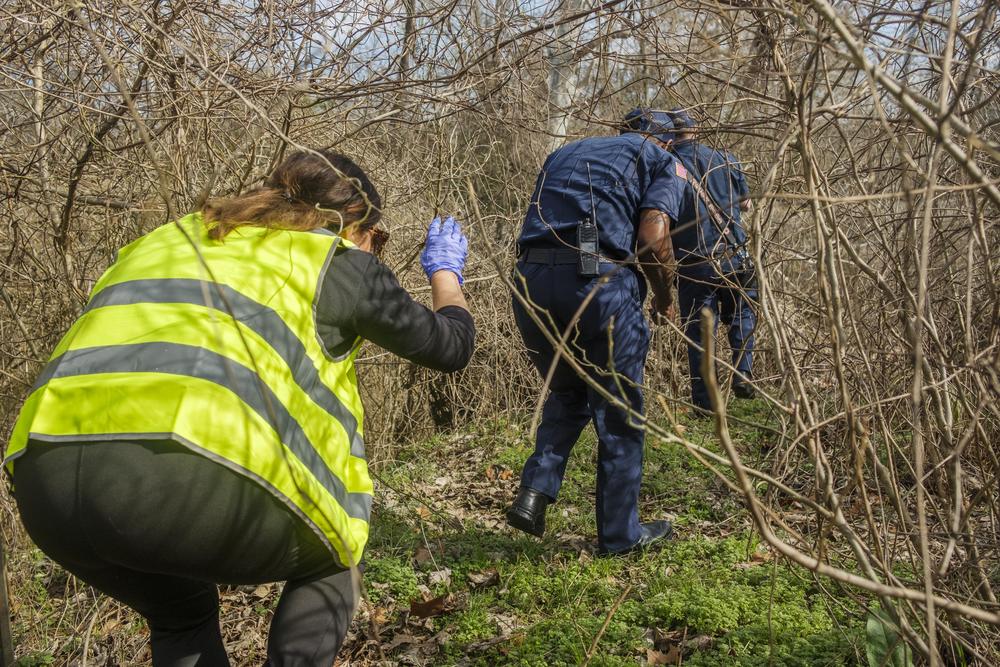
Caption
Heather Sims follows firefighters to a homeless encampment wedged up against Macon's interstate bypass.
Credit: Grant Blankenship / GPB News
|Updated: February 21, 2024 3:50 PM
Jake Hall wanted a baseline. A fresh start and a sense of direction in how to make life better for unsheltered people in Macon.
That first required knowing how many of them there even were.
That’s why on a cold and clear but blustery morning out by Interstate 475 where it crosses over Eisenhower Parkway in Macon, Hall looked for a homeless encampment which, up until then, had only been a rumor and a spot on a map built by a new app on his phone.
The manager of a rent-by-the-week hotel knew the spot well.
“Yeah, we kind of blocked it off,” the manager tells Hall. “They used to go in behind our dumpster back there. When they had the fire over there, it kind of ran them off a little bit.”
The fire was a few years ago, but it was so big that firefighters remember the site. That’s why Hall, who leads the United to End Homelessness Program in collaboration with Macon-Bibb County Government, is even here.
This place is new to him, but it’s one of a number of homeless encampments around the county that firefighters have been mapping when they are out on calls. They're leading him and his colleague Heather Sims to the site now, as Hall, Sims and teams of volunteers around the county are near the end of the Macon stretch of the bi-annual national census of unsheltered people known as the Point in Time, or PIT count.
Hall, the firefighters, and Sims pick their way through the privet and undergrowth until they find the encampment. No one is home.
Hall breaks out his phone and makes a note of what he sees.
“Large encampment filled with debris. Burned out from the previous fire period. All right, I tallied it, so we got it here,” he says first to his phone and then to the group.
Sims, retired from decades as a mental health counselor in the Bibb County Jail, sees something else, details that add up to a new inference about who periodically calls this patch of woods home: a tiny pink Croc shoe and a coat to match.
“We've counted a lot of adults, but we haven't seen any children,” Sims says of their census efforts thus far. The observations here will be counted statistically even absent flesh and blood people to interview.
“This is evidence that this is a part of the story that we're not seeing,” Sims says. “The little bitty shoe and the super small fleece coat. It's just evidence that this isn't just a 35-year-old male problem."
“This is systemic.”

Heather Sims follows firefighters to a homeless encampment wedged up against Macon's interstate bypass.
It may seem like there are more people living unsheltered. But the people who try to help the chronically homeless need more than gut feeling to inform where and how they work. They need hard numbers.
In Macon, hard numbers have been hard to come by. Today, Hall has what he hopes are better numbers.
That’s because Jake Hall’s new, technology driven approach to the PIT census was aimed at better informing the process ahead of time and going to places which, and people who, may have never been counted before.
As far as Macon-Bibb County government is concerned, Hall has only been the point person to the larger, more established coalition of homeless service providers for barely a year.
The effort to count Macon’s homeless long preceded Hall’s position.
“But when you look at our metrics, it's difficult to determine exactly how many people are unhoused here in Macon-Bibb,” he said.
That’s because the metrics are hard to find. Or more precisely, they are hard to break out of the larger whole.
Most Georgia cities bundle all their homeless service providers — the churches, the shelters, the food banks — into a single organization called a Continuum of Care. The federal department of Housing and Urban Development, or HUD, prefers to deal with, and maybe more importantly, to fund Continuums of Care, or CoCs.
But Macon-Bibb County does not have a CoC of its own. Instead it and 151 other counties are rolled up into a huge statewide CoC: the Balance of State CoC.
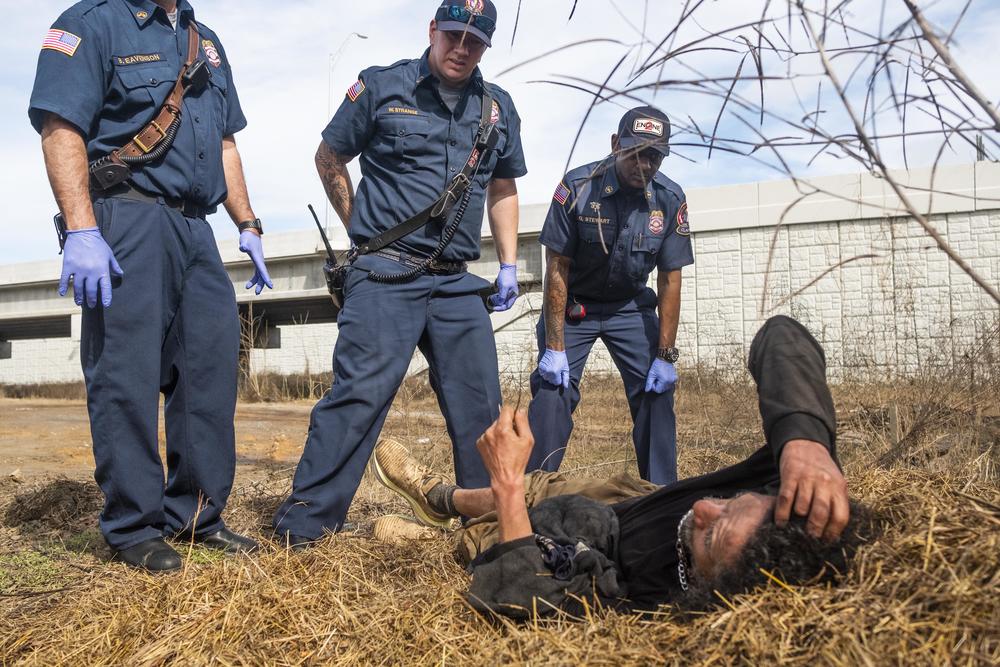
Firefighters leading a contingent of homeless census takers tend to an unsheltered man experiencing a medical issue by Interstate 16 in Macon. Firefighters and other first responders who frequently encounter unsheltered people informed the direction and geography of Macon's 2024 census of the unsheltered.
And so Jake Hall said, typically when the homeless count is done for Macon, there’s only so much you can learn.
“There are 10,000 homeless people across 152 counties,” he said. That’s the kind of data available from the state Department of Community Affairs. “That's not data that we can operationalize. Our nonprofits can't take that data and then structure their budgets around it.”
Hall said it took seven months of emails back and forth to DCA just to get local numbers from the last count in 2022.
This sort of thing so frustrated the Bibb County Commission that years ago, before Hall was on the job, they passed an ordinance mandating a local supplemental count of the unsheltered homeless.
A big change this year: As a regional administrator for this year's PIT count, Jake Hall is now positioned in the middle of the informational stream of the homeless census between grassroots collection and the reporting back to HUD. He has been able to see the census dashboard as it was coming together and to capture the local numbers.
There’s another change Jake Hall implemented to put new muscle into the local count — which comes back to how the firefighters have been able to map encampments ahead of time.
It’s an app, available on iPhone and Android, called Show the Way.
Firefighters were trained on Show the Way in the lead-up to the PIT count. Walking toward another newish encampment, this time out by Arkwright Road in north Bibb County, Pvt. Michael Thomas explained how it works.
“So it's simple; it's three buttons you push,” he said.
Button 1 brings up your position — the spot where you are looking at a new-to-you homeless encampment — as a marker on the map.
“You just move it and pin it,” Thomas said. “It’s very easy to use.”
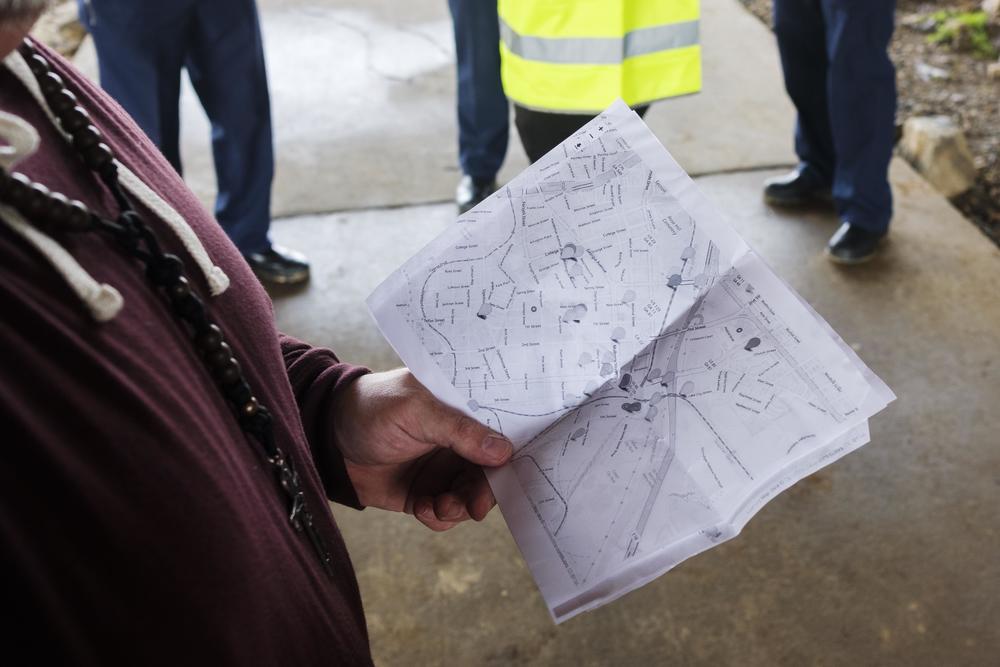
Jake Hall holds a paper copy of the map he and census volunteers used to inform their 2024 count of unsheltered homeless in Macon.
The civilian version of the app gives you the option to estimate how many people might live in the structure.
Jake Hall said Macon-Bibb code enforcement officers have been using the app in their day-to-day work, too.
The result was that when it came time to do the official 10-day census, volunteers had a pre-populated map showing them where they needed to go. Census takers documented what turned out to be relatively massive but little-known settlements.
Some, like the burned-over encampment at I-475, are upwards of 10 miles away from any of the centers for homeless services. Others are so big that firefighters say the people living there have their own mayor to settle disputes.
On the way to yet a third, Jake Hall ran into a living, breathing person. That presented an opportunity to roll a life story into an otherwise raw number.
“Hey, brother! Can you talk to us for a second?” Hall shouted across two lanes of traffic on Spring Street from his driver seat to a man with a panhandling sign. “Would you answer some questions?”
He wrenched the SUV to the side of the road. Heather Sims broke out her phone for an interview perched on the highway guardrail.
“How long have you been homeless?” she asked.
“Off and on all my life,” he said.
She asked more questions: "Has anyone diagnosed you with mental health issues?"
"No, but I did have my nose broken."
"Have you had an HIV test recently?"
"No, but I’d like one."
The questions may seem indelicate, even intrusive, but they were aimed at quickly getting a picture of the man’s needs.
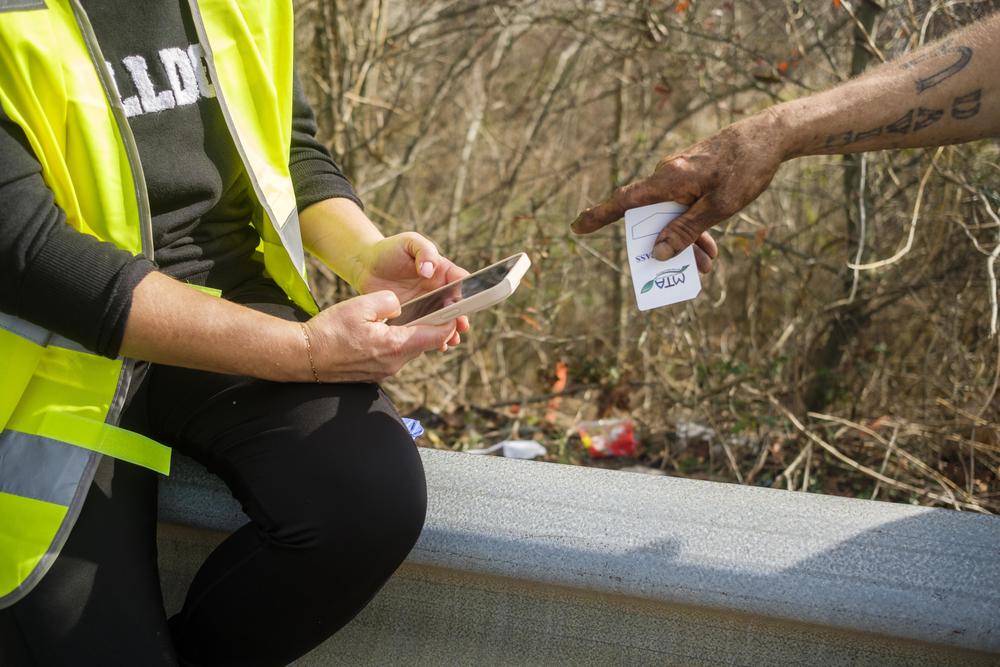
Heather Sims conducts a phone-based-app interview and needs assessment with a man who, by his account, has been homeless his entire life.
Going forward, the hope is to use Show the Way as a rolling, ever updating very local picture of where people are in need.
“You can request assistance for someone that you might have an encounter with on the street rather than handing out a dollar,” Hall said.
That’s after the full public rollout. For now the focus is on training first responders, law enforcement officers and service providers on the app.
Since Show the Way records data in the same format as the app HUD prefers for their records, Hall said he hopes over the longer term for the two to become indistinguishable sources of data and to create a constant stream of knowledge rather than a once-every-two-years snapshot.
“Then there's a virtuous cycle instead of the vicious cycle of not knowing,” he said.
A few weeks after the conclusion of the census, Hall had preliminary numbers to report during the regular meeting of the local homeless coalition. First, there were issues to work through with the Zoom meeting.
“Can you hear me now? Yes. Sorry about that,” Hall said after straightening out an echo on the line. “So we're getting closer on honing in on something that I think we collectively know to be true: that we have more than 140 unsheltered people out there.”
Closer but not absolutely assured. Because comparing 2024 to 2022, Hall said, is not an apples to apples comparison.
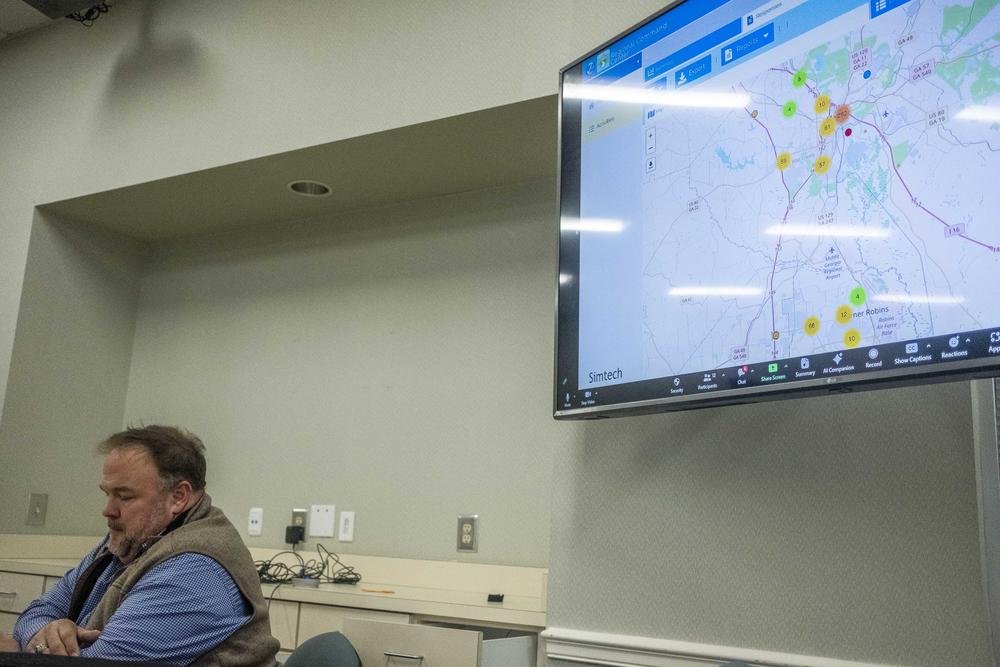
The United Way's Jake Hall presents the first rough numbers in Macon's 2024 homeless census to members of the local homeless coalition a few weeks after the close of the census.
“We did 195 interviews, 194 observations of people and then 75 structural observations representing large encampments, tents, tarps, a bedroll, anything that was deemed active on that night,” Hall said. “In 2022, that was 114 interviews and only 43 observations. And we were not tracking, active encampments in the same way at that time.”
So it should not be shocking at all that the first rough estimate of the 2024 number of unsheltered homeless in Macon is something like three times higher than the estimate from the 2022 count.
Whether the new estimate reflects undercounts in previous years or real growth in the number of unsheltered homeless in Macon will bear itself out after the numbers are refined and after years of more counting. United to End Homelessness is hiring a number of part-time social workers to, in part, keep these numbers fresh in between federally mandated counts. Heather Sims is already one of those outreach workers.
In the meantime, the new numbers are at least a fresh place to start.